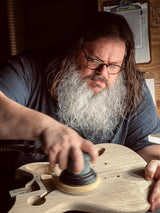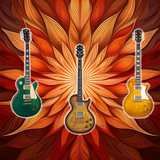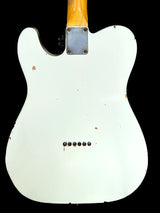Most of us, electric guitar players, use guitar picks. Some chosen ones (like Jeff Beck) just drop the pick one day and become the divine creatures able to play virtually anything with fingers only. The remaining majority will use the pick either most of the time or occasionally. The pick makes the connection, a gluing part between the picking hand and the guitar. That's why it is one of the most, if not the most, factors that will affect our playing style.
The blissful ignorance
First of all - if you haven't yet paid enough attention to the pick you're using - it's really important you do. You may realize that the things you've been struggling with, playing riffs or lead lines, can really be much easier when using different shapes or thicknesses of the pick. I cannot stress it enough - spending time trying various picks is as important as choosing the proper guitar for your style. We'll try to help you by pointing out things you should be mindful of, but we cannot decide for you. Picks are cheap and you can find them in any shape and form, so be brave, be crazy, be open-minded - go ahead and explore different possibilities.
The shape
The single most important aspect of choosing a guitar pick is its shape. By shape, we mean the overall shape of the pick and the shape of the tip.
The overall shape of the pick will affect the way you feel the pick in your fingers. Bigger picks are easier to grab and provide more friction. Go for it if you like to hold the pick with your whole thumb and the side of your index fingers or you like to leave a lot of the pick outside. V-Picks Screamer might be a good choice for you. On the other side, if you prefer to hide most of the pick inside your fingers and only use its tip or you simply don't like the feeling of a bigger pick - choose something smaller (maybe Dunlop Jazz III).
The shape of the pick's tip will affect the note-attack and precision of picking. You might have a very sharp, precise tip or a very wide, fat tip. Imagine you are trying to play guitar with a big, round coin. It will be very easy to slide it across the strings but you won't have much control over which strings you're picking due to its size. On the other hand, if you tried to play guitar with a match stick, you would have amazing precision (because it's small and pointy) but it would be extremely difficult to drag it across the strings. Picks with sharp tips give you great precision and control over attack but they are generally harder to move across the strings, you really need to have your wrist movement in place. Players who choose them are very often shred, metal players. Picks with rounded tips are easier to move across the strings but not as precise. They are great for strumming, and rhythm playing.

Not always sharp pick is best for fast playing. It heavily depends on your stile, the angle at which you hold the pick, and the movement of the wrist. Start with a pick with a more rounded tip and try different lines, licks, and riffs. Then decide if you need more precision or a more relaxed, rounded tip.
The thickness
The thickness of the pick might affect its attach and tone and will have the most impact on the rigidity of the pick. Thin picks are great for rhythm playing, strumming chords is effortless. They don't have much attack though and when you hit them harder - they bend easily. Thin picks (say, 0.6 mm) are great for beginners when learning strumming. A bit thicker picks (around 0.8-1.2 mm) are a safe balance of rigidity and nice elasticity, great for overall playing. Thicker picks (around 2mm) are often chosen by lead players due to their very fast attack and good bounce. Try Dunlop Flow Jumbo for example.
There are also very thick picks (3-4mm and even more) if you like something extreme, Dunlop Big Stubby maybe?
The texture
The texture of the pick affects the friction between the surface of the pick and our fingers. If you like a better grip or struggle with sweaty fingers, an additional grip might be helpful, try Dunlop Max-Grip picks for example.
It comes with a trade-off though - the pick will feel more "glued" so if you like a little movement of the pick in between your fingers, more grip will affect it. Some pick manufacturers, like Rombo Picks, use different textures in various parts of the surface to increase the grip but allow some flexibility in the movement.

The material
Picks are made of various materials nowadays - from plastic, plexiglass, ceramics, glass, wood, metal, and others. The used material will have a significant effect on the tone and durability of the pick (or strings). If you choose a very soft material (wood or light plastic) you might experience a very fast wear of the pick. It might be something that you like - the pick will be softer to play. Also, the tone of softer materials is rather mellow, nice for those looking for jazzy, bluesy sounds.
Hard materials like glass or metal will have very distinct, bright tones and fast attack. They might also wear the strings due to significant friction.
A very interesting material is Graphtec TUSQ. It is lightweight and moderately soft but can produce bright, glassy tones. One of the best pick materials for sure.

The choice is yours
Picks are cheap and they come in a huge variety. You can just go to your local guitar store and buy 10-20 of them, as different as you can, and try them one by one, consciously considering the above-mentioned factors. A great way to try a huge array of possibilities is to purchase Rombo Variety Pack which provides 12 different models to give you all the choices possible. 
Try to narrow your favorites to 3-5 and spend some more time with each one. Play your favorite songs, and use them in practice sessions. Go back and forth but always be sure to give each some time until you find the perfect one.



